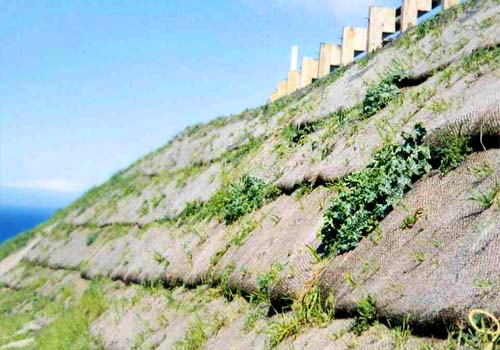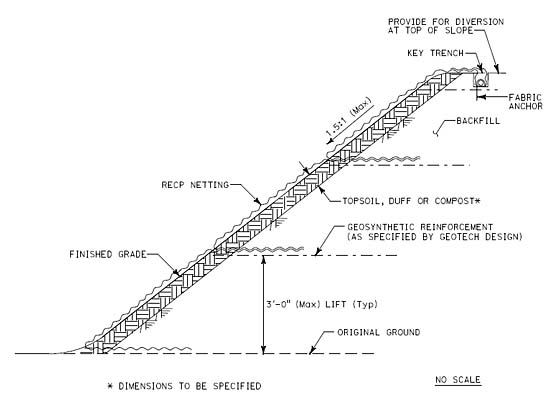Erosion Control Toolbar: Rolled Erosion Control Product (Wrap)
Introduction

Slopes steeper than 2:1 (H:V) require a more aggressive approach to control erosion, particularly at the slope face. This treatment builds up embankment (fill) slopes by wrapping slope backfill material in Rolled Erosion Control Products (RECP) to resist soil and hydrostatic pressures that may cause erosion. The layers of materials typically consist of:
- Geosynthetic reinforcement - typically placed 2' on center vertically
- Backfill - typically structural material, local topsoil, imported topsoil, and/or compost
- Rolled Erosion Control Product - coir/coconut blankets placed every other geosynthetic layer or 4' on center vertically, which wrap the vertical face of the slope
RECP Wrap Training Video
Click here to watch a short video about RECP Wrap.
When to Use This Treatment
- Use to construct embankment (fill) slopes between 2:1 and 1.5:1 (H:V)
- Use in lieu of RECP Flap where there are subsurface water flows
- Coordinate the use of this technique with Caltrans Division of Engineering Services (DES) Office of Geotechnical Services, which may prepare a Geotechnical Design Report for slopes greater than 2:1 (H:V)
Consider Using With
How is This Treatment Constructed
- Structural backfill is placed in 8-inch lifts, and "keyed-in" to the adjacent existing slope at least 6.5 feet horizontally. Lifts of backfill are compacted to 90% by track-mounted crawlers.
- A geosynthetic reinforcement layer is placed horizontally between structural backfill lifts, typically every 2' on-center vertically.
- Following placement of the first geosynthetic reinforcement layer (and at every other primary geosynthetic reinforcement layer thereafter) RECP is placed and fastened longitudinally with fabric anchors.
- Placement of structural backfill and geosynthetic reinforcement continues in layers, like a cake. At every other geosynthetic reinforcement layer, typically every 4' on-center, RECP is wrapped around the slope face as shown below.

Note: This typical section is schematic only and is not to be used in a contract document. The scale, key dimensions, and critical details have been intentionally omitted.
Benefits
- RECP Wrap protects the slope from surface erosion
- The slope face is stabilized and protected from storm events as the embankment (fill) is constructed, therefore construction may resume immediately after rainfall
- Promotes vegetation establishment and natural succession
Limitations
- May be cost prohibitive on large earthwork projects
- Must be implemented during construction of embankment (fill) slopes and cannot be retrofitted
- Unsuitable for embankment (fill) slopes steeper than 1.5:1 (H:V) or slopes with limited access
- Vegetation establishment may be limited when specifying a RECP with limited open area - such as 900 grams/square meter coir netting
Technical Design Tips
- Always protect the face of embankment (fill) slopes steeper than 2:1 (H:V) to prevent the slumping of soil from between horizontal geotextile layers.
- Consider covering (wrapping) the face of 2:1 (H:V) embankment (fill) slope faces, based upon evaluation of constraints to compaction, angle of repose, backfill material, and rainfall intensities.
- Backfill lifts typically range from 2 - 4 feet thick. Consider specifying Local Topsoil on the outer face of structural backfill lifts.
- Fill slopes steeper than 2:1 (H:V) typically require reinforcement by a geosynthetic fabric such as a geogrid. Geosynthetic reinforcement strength needs to be sufficient to meet slope engineering requirements and should be specified by a geotechnical engineer.
- Consider the benefits and liabilities of natural geosynthetic products versus longer lasting inorganic (plastic) products.
Updated: February 1, 2019

